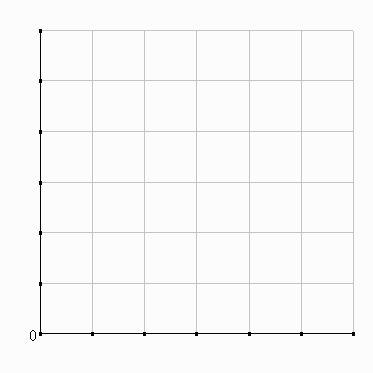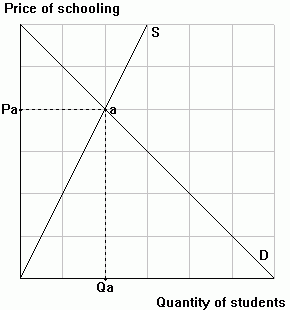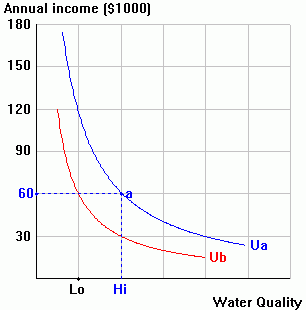
Worksheet: Applying microeconomics to the economic analysis of the law
Part 1: Review of markets and efficiency
| 1.1 | Individuals act to maximize their welfare. |
 |
|
| a. | Use the axes to the right to illustrate a utility-maximizing optimum for a consumer that spends her entire entertainment budget on concerts (C) and movies (M). Put C on the horizontal axis. | ||
| b. | How do the slopes of the budget line and indifference
curve compare at the optimum? What does that tell you?
|
||
| c. | Suppose the consumer's entertainment budget increases. Illustrate what a new optimum would look like. | ||
| d. | Suppose instead that the price of concerts rises. Illustrate what a new optimum would look like. | ||
| 1.2 | Markets typically promote efficiency. |
|
|
| a. | Consumers: Use labels from the diagram to show where
total benefit (TB), total expenditure (TE) and consumer surplus (CS)
show up when the market is at its equilibrium. [Hint: TE = (Price buyers
pay) x (Quantity buyers purchase)] TB = ________ TE = ________ CS = ________ |
||
| b. | Producers: Use labels from the diagram to show where
total revenue (TR), total cost (TC) and producer surplus (PS) show up
when the market is at its equilibrium. TR = ________ TC = ________ PS = ________ |
||
| c. | Illustrate in the diagram the minimum welfare loss when the market quantity is Qlow. | ||
| d. | Illustrate in the diagram the minimum welfare is loss when the market quantity is Qhigh. | ||
| 1.3 | A situation is efficient when it is Pareto optimal | ||
| a. | State the Pareto optimality condition:
|
||
| b. | The Pareto optimality condition provides the basis for the following: | ||
| Pareto efficiency criterion: A change is welfare-improving if it makes at least one person better off without making anyone else worse off. | |||
| Critics of using the Pareto efficiency criterion to guide policymaking argue that little would ever get done if policies were implemented only when they satisfy the Pareto efficiency criterion. The critics propose the following revised criterion for real-world policymaking: | |||
| Kaldor-Hicks efficiency criterion: a change is welfare-improving if the winners gain more than the losers lose. | |||
| A change that satisfies the Kaldor-Hicks efficiency criterion is
considered to be "potentially Pareto-improving." What do you think is
the basis for that assessment?
|
|||
Part 2: Markets and externalities
| 2.1 | Case 1: Pecuniary externalities: Example:
Competition Consider the following quote from an 18th century English judge referring to a court case from 1410: "One schoolmaster sets up a new school to the damage of an [existing] school, and thereby the scholars are allured from the old school to come to his new." |
 |
|
| a. | The diagram to the right depicts the situation in the schooling market prior to the entry of the new school. Use the diagram to depict what happens when a "schoolmaster sets up a new school." | ||
| b. | Illustrate where "damage" to existing schools shows up in the diagram. | ||
| c. | Illustrate the impact of the new school on consumer welfare. | ||
| d. | Illustrate the impact of the new school on the welfare of the new schoolmaster. | ||
| e. | Should the court allow the original schoolmaster(s) to
collect damages from the new schoolmaster? Why or why not?
|
||
| 2.2 | Case 2: Nonpecuniary externalities:
Example: Pollution Consider the impact of carbon emissions on global warming. Fossil-fuel power plants are a major producer of carbon emissions. The diagrams below illustrate the two relevant markets. |
|||||
|
||||||
| a. | In the carbon emissions market, indicate the quantity of carbon emissions if there is no policy to ensure that the external costs are internalized. | |||||
| b. |
Why are there marginal benefits from carbon
emissions? Marginal costs?
|
|||||
| c. |
Suppose the government imposes a carbon tax that limits
carbon emissions to their optimal level. (Note: This is sometimes called
a "Pigouvian tax"). How large will the Pigouvian tax be? $________ Illustrate it in the carbon emissions market. |
|||||
| d. | Illustrate the impact of the carbon emissions tax in the fossil-fuel electricity market. | |||||
| 2.3 | Case 3: Pollution policy--Example 2 | ||
| a. | Consider a small private lake. A fishing
resort owns 1/2 of the shoreline, and a chemical factory owns the other
1/2. If the chemical factory does not pollute the lake, the fishing
resort earns $50,000 of profit per year. If the chemical factory does
pollute the lake, it kills most of the fish, and the fishing resort
profit falls to $10,000 of per year. What would be the Pigouvian remedy
to this pollution situation?
|
||
| b. | If the chemical factory pollutes the lake, it earns $50,000 of profit per year. The factory can produce its output without polluting the lake if it leases pollution-control equipment for $30,000 per year. | ||
| (1) | Will the factory pay the Pigouvian tax? Why or why not?
|
||
| (2) | Does the Pigouvian tax raise social welfare? How did
you decide?
|
||
Part 3: Coase and externalities
| 3.1. | Does the assignment of property rights
matter? The diagram to the right illustrates consumption for Kelty, who lives on the shore of a lake and derives utility from the water quality of the lake and from money income. Initially, the water quality of the lake is at Hi, and Kelty consumes at point a and enjoys utility Ua. |
 |
||
| a. | Now suppose a factory locates on the opposite shore of the lake. Its pollution reduces the water quality of the lake to Lo. Use the label b to indicate Kelty's new consumption point in the diagram. | |||
| b. | Kelty files a lawsuit to enjoin the factory from polluting the lake. | |||
| (1) | Suppose that Kelty wins the lawsuit and is awarded the right to a pollution-free lake. Use the label A to indicate in the diagram the minimum amount of income that the factory must pay Kelty to get his permission to pollute the lake. | |||
| (2) | Suppose that Kelty loses the lawsuit, and the factory is awarded the right to pollute the lake. Use the label B to indicate in the diagram the maximum amount of income that Kelty will pay the factory to stop its polluting. | |||
| c. | Suppose that the cost of maintaining a pollution-free lake, C, is between the values A and B. Will the outcome of the lawsuit in part b affect the lake's water quality? Explain. | |||